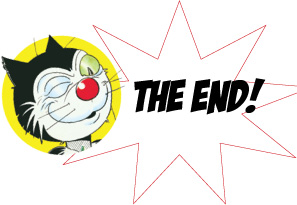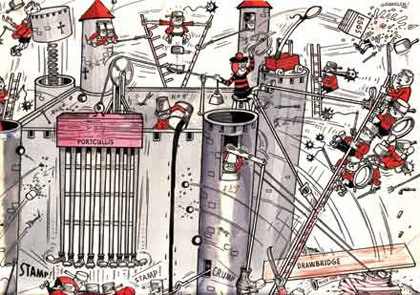Indeed, in a worldwide league table of cities who might claim the title 'Capital of Comics' Dundee rates very highly, alongside London, New York, and Tokyo. In spite of this few Scots seem to be fully aware of the significance of Dundee's comics, and still fewer would claim them as a source of pride. Consequently, Scots as a whole, and Dundonians in particular, do not celebrate their place in the history of comics. However, the last two decades have seen an incredible rise in comics scholarship, as well as greater aesthetic appreciation of the medium.
Perhaps it is time to reconsider the worth of this incredible cultural legacy. Where once original comic art was thrown away it now commands high prices, and copies of old or rare comics reach staggering sums at auction. In 2004 a copy of The Dandy #1 sold for £20,350, while a copy of The Beano #1 sold for £12,100 at auction, and in June 2006 a simple signed sketch of Oor Wullie by Dudley D. Watkins was sold for £950. With this in mind it is important to celebrate the huge influence DC Thomson had on comics, both nationally and worldwide, and the significance that these comics still have.
When DCT moved into the production of comics it was already well established as a publisher, having consolidated its monopoly of Dundee's newspapers in the 1920s. Its two most famous comics, The Dandy and The Beano, appeared in the late 1930s, and were immediately popular, and both have managed to survive to this day, an incredible feat in today's comic marketplace. The reasons for this are numerous, but it is worth noting that DCT's comics have changed very little over the years, at a time when other comics have been highly influenced by competing mediums from television to film, computer games and the internet.

While other comics have attempted to capture trends or follow changes in youth culture, DCT's comics have resisted the temptation to follow fads. That is not to say that the comics have not changed at all (far from it), but rather that change has come very gradually. However, at one point the success of DCT's comics was based on a crucial innovation. From the beginning DCT drew on a long tradition of humorous strip cartooning and comic art. This traces its modern roots back to Hogarth and Gillray, whose satirical prints of working class life and political scandal helped define the spirit of the British press throughout the 18th and 19th centuries.

By the mid 1880s, by which time DCT had firmly established itself in journalism, this tradition of satirical cartooning was starting to develop in other ways, moving out of the newspapers into separate publications. Indeed, the famous Victorian character Ally Sloper, by Charles Ross, William Giles Baxter and others, was so popular that he appeared in his own publication, Ally Sloper's Half Holiday (1884), generally regarded as the first modern comic. This trend was irresistible, and soon the market was flooded with publications devoted to humorous comic strips. In the closing decade of the 19th century, Alfred Harmsworth revolutionised British comics by introducing weekly publications such as Comic Cuts and Illustrated Chips (both 1890-1953). These were enormously successful, leading to Harmsworth setting up Amalgamated Press in 1901. This would establish the marketplace for comics in Britain that DCT would come to dominate.
The AP style was to have images accompanied by text underneath, and in most cases it seemed as if the images merely illustrated the descriptions given in the text. In the 1930s Amalgamated Press began to reprint some American comics for the British market, notably the incredibly popular Superman stories. These strips were quite different from British comics in that they did not have accompanying text at the foot of the images, and the stories were longer.
This made for a much more appealing, dynamic narrative which played on visual action and was not necessarily tied to a rigid panel format. When The Beano and The Dandy appeared in the late 1930s, joining the adventure comics Rover, Wizard, Adventure, Hotspur, and Skipper that DCT had already created to challenge Amalgamated Press, they had clearly picked up on this aspect of American comics, dropping the textual exposition in favour of visual gags, making them seem more vibrant and exciting than the rather staid Amalgamated Press format that had held sway for decades. This new style in British comics revolutionised the comics industry, and made The Dandy and The Beano household names.
Another reason for the success of DCT's comics was that they were calculated to appeal to children rather than parents, so they seemed much more raucous and anarchic than their competition at Amalgamated Press. Whereas AP comics were quite gentile and mannered DCT's were brash and featured working class characters (with the obvious exception of Lord Snooty!). They appealed to children growing up in hard times, and were a distraction from the grim realities of the Depression and rationing.

This also explains the fascination with 'grub', with memorable scenes of the Bash Street Kids and the Broons tucking into hearty meals, and Desperate Dan rounding off a hard day's work performing incredible feats by digging into a huge cow pie. Such themes continued throughout and indeed after the war, reflecting a fantasy of better times to come. In this sense the comics represent a kind of social history of Scotland, reflecting the character of the times, with humour and crafty japes keeping spirits high in times of deprivation. Few working class families in Scotland could have failed to appreciate the vision of tenement life given by The Broons. Like Oor Wullie, this was a strip that appealed to Scottish readers because it presented them with a world they recognised, albeit a highly romanticised view. As Roger Sabin, one of Britain's foremost comics historians notes, [The Dandy and The Beano] redefined the humour genre altogether. These comics introduced a new type of sharper, more knockabout japery, and a range of bizarre but loveable characters that made the old AP stable look decidedly dated (Roger Sabin, Adult Comics: An Introduction, London, Routledge, 1993, p.23).

The success of these comics presented a clear challenge to AP's virtual monopoly over the comics industry at this time, a Scottish invasion that affronted many English publishers but captured the imaginations of readers nationwide. Part of the success of The Beano and The Dandy was that they offered such bizarre and memorable characters, like Desperate Dan by Dudley D. Watkins and Korky the Cat by James Critchton, as well as Dennis the Menace by David Law, and Minnie the Minx and the Bash Street Kids by the hugely influential Leo Baxendale, who came from the North of England. DCT also showcased Dudley D. Watkin's considerable talents in the strips Oor Wullie, and The Broons, which appeared in The Sunday Post newspaper as well as some of the comics (such as The Topper and The Beezer). The simple, appealing style adopted by these artists was surely one of the major factors contributing to their success. Watkins had a style all of his own, moving at quite a slow pace, matching the tone of his humour, which seemed gentler than his colleagues, growing out of observations about family life and the peculiarities of dialect and habit, rather than cow pies and disruptive bodily functions.

For a time in the 1950s and 60s DCT's comics were the very best in Britain, and enjoyed worldwide circulation.
The less polished but always energetic artwork of Baxendale, Critchton, Reid, and Law seemed to embody a loose house style for DCT, geared towards dynamism and excitement, full of speed lines indicating movement and a general sense of calamity and action. This perfectly complimented the brash, schoolboy humour of the strips. Colour was also of great importance, and many of these strips liberally splashed bold primary colours over the page - notably the red of Desperate Dan and Dennis the Menace, which made them instantly recognisable.
For a time in the 1950s and 60s DCT's comics were the very best in Britain, and enjoyed worldwide circulation. This was undoubtedly due to the fact that this Dundee company had managed to attract the very best artists, and had given them a forum in which to let their imaginations run riot.
Another important factor in the success of these strips in Scotland was that they celebrated the Scots vernacular, with phrases like 'that's braw', and 'Jings! Crivens! Help me Boab!'. Although few young Scots actually spoke like this or wore red and black striped jumpers they recognised something familiar in Our Wullie and Dennis.
In a Scotland without leisure centres, bowling alleys, and alchopops these were strips that extolled the value of carty races, washing windows to save up money to buy that red toy boat, and, occasionally, of knocking a policeman's hat off with a slingshot.
Nostalgia for an age gone by, or that never was, was clearly a strong part of the appeal of such strips, and has ensured that they have remained part of the national consciousness.
This is evidenced by the fact that the Oor Wullie and The Broons annuals have long been traditional Christmas stocking fillers and often appear on bestseller lists in Scotland. Indeed, they are almost embedded in a sort of national myth of the past, and many older Scots seem to think of their childhood in terms of an imaginary nostalgic montage of The Broons and The Bash Street Kids. If you look hard enough in Dundee pubs you will find old men with a dram in hand who will swear they were raised on cow pies. Perhaps this investment in nostalgia, memory and national identity is why these strips have been so resistant to change.
In spite of the huge changes in the comic marketplace over the last 70 years, The Beano and The Dandy are still going strong, but today they have to compete with computer games and other forms of hi-tech entertainment for children's attention. Looking at DCT's flagship comics today it is incredible to see how much certain elements have transformed while others have hardly changed at all since they first appeared. Strangely, very traditional strips like 'The Bash Street Kids' and ' Desperate Dan' now sit alongside 'Jak' and 'Joe Jitsu', which have computer colouring and the now very popular 'manga' styling ('manga' = Japanese comics).
This recent revamp demonstrates that DCT is changing its comics to suit an ever-changing marketplace, and one can now find Dennis the Menace on the internet and in animated cartoons. Times have changed, but DCT still contribute a great deal to the comics industry, and have hidden in their archives a rich and diverse range of material that comics scholars and cultural historians yearn to gain access to. Perhaps the time has come to see the value of DCT's contribution to comics, nationally and internationally, and to celebrate Dundee as the Capital of Comics.






